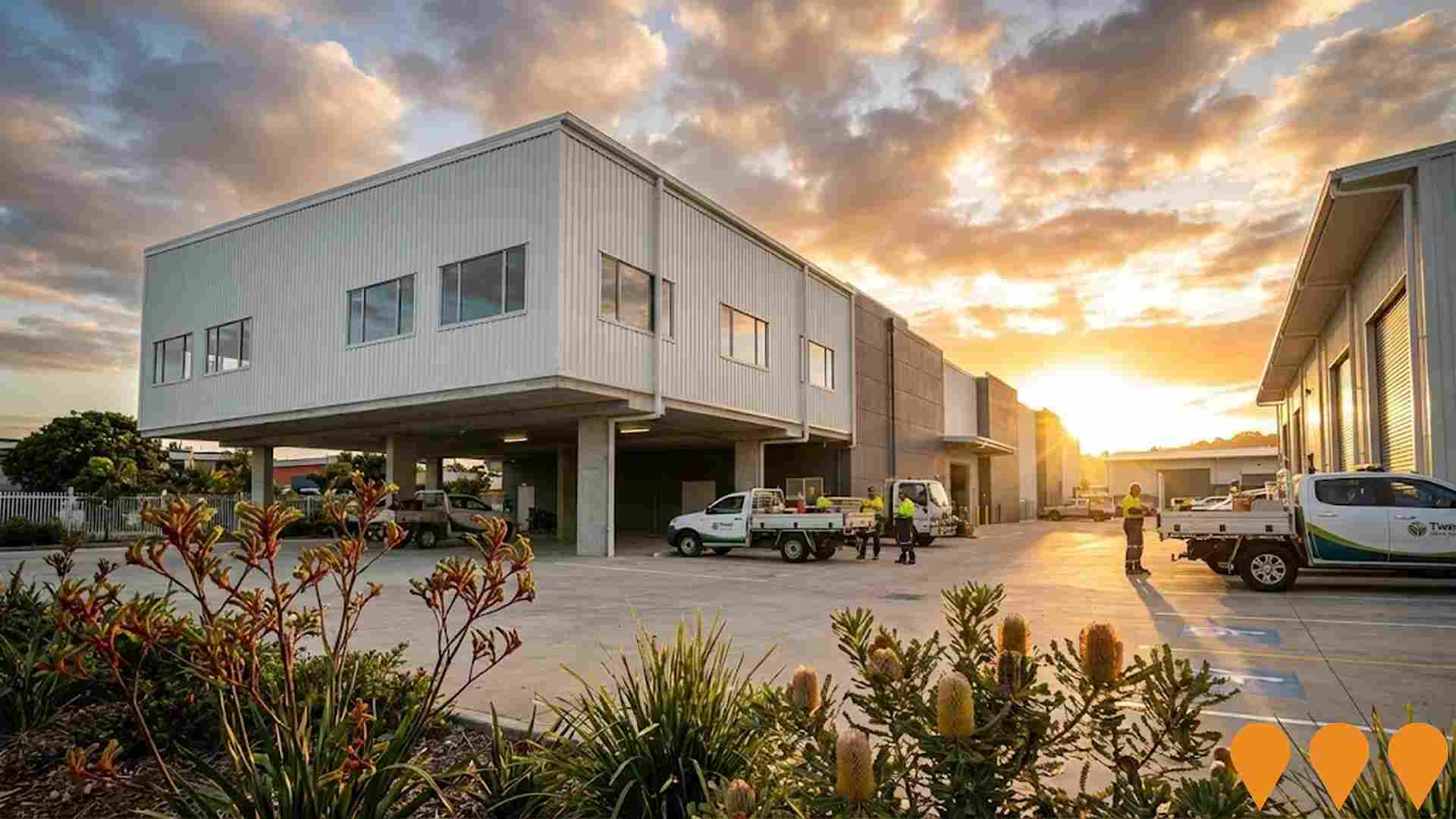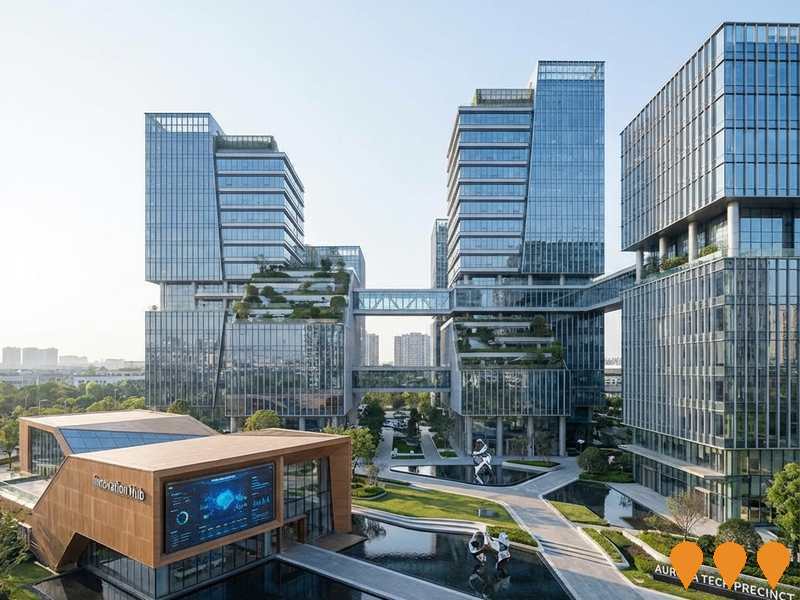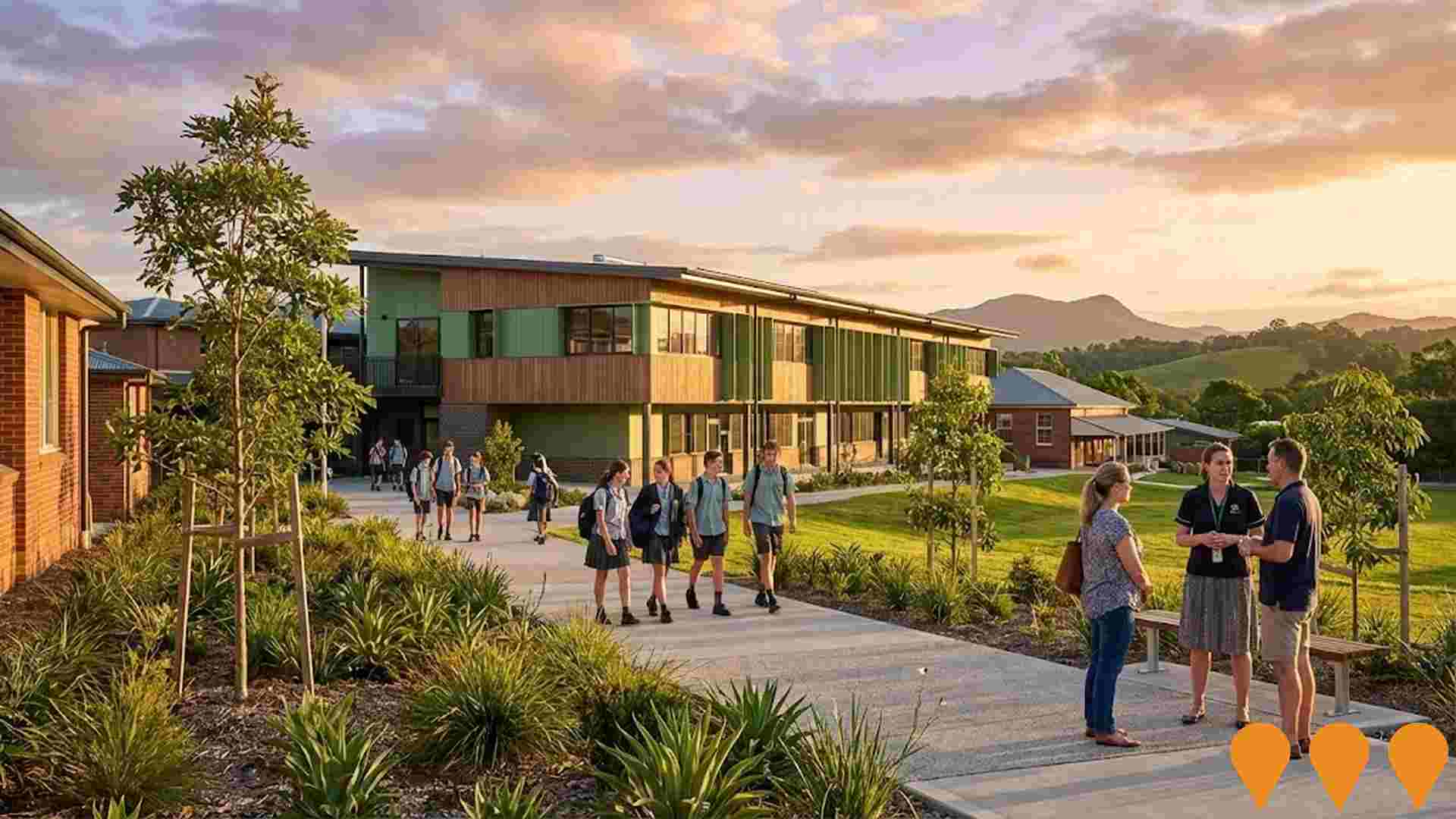Chart Color Schemes
est. as @ -- *
ABS ERP | -- people | --
2021 Census | -- people
Sales Activity
Curious about local property values? Filter the chart to assess the volume and appreciation (including resales) trends and regional comparisons, or scroll to the map below view this information at an individual property level.
Find a Recent Sale
Sales Detail
Population
Population growth drivers in Murwillumbah Surrounds are strong compared to national averages based on AreaSearch's ranking of recent, and medium to long-term trends
Murwillumbah Surrounds' population is 10,799 as of Nov 2025. This shows a 447 person increase from the 2021 Census figure of 10,352 people, representing a 4.3% growth. The change is inferred from ABS's June 2024 estimated resident population of 10,695 and an additional 56 validated new addresses since the Census date. This results in a density ratio of 11.9 persons per square kilometer. Murwillumbah Surrounds' growth exceeded SA4 region's 3.3% growth rate since the 2021 Census. Interstate migration contributed approximately 36.0% of overall population gains during recent periods, with all drivers including overseas migration and natural growth being positive factors.
AreaSearch uses ABS/Geoscience Australia projections for each SA2 area released in 2024 with a base year of 2022. For areas not covered by this data, NSW State Government's SA2 level projections released in 2022 with a base year of 2021 are used. Growth rates by age group from these aggregations are applied to all areas for years 2032 to 2041. By 2041, the area is projected to expand by 2,061 persons based on latest population numbers, recording an 18.1% total gain over the 17-year period.
Frequently Asked Questions - Population
Development
Residential development activity is lower than average in Murwillumbah Surrounds according to AreaSearch's national comparison of local real estate markets
Murwillumbah Surrounds has seen approximately 13 new homes approved each year over the past five financial years, totalling 67 homes. In FY26 so far, 16 approvals have been recorded. On average, 8.6 new residents per year arrived for each dwelling constructed between FY21 and FY25. This has led to a significant outpacing of demand over supply, which typically puts upward pressure on prices and increases competition among buyers.
New properties are constructed at an average expected cost value of $390,000. In the current financial year, $19.9 million in commercial development approvals have been recorded, suggesting balanced commercial development activity. Compared to the rest of NSW, Murwillumbah Surrounds has significantly less development activity, 58.0% below the regional average per person. This scarcity typically strengthens demand and prices for existing properties. The area's recent construction comprises 90.0% detached houses and 10.0% medium and high-density housing, preserving its low density nature and attracting space-seeking buyers.
As of now, there are an estimated 1545 people per dwelling approval in the area. Population forecasts indicate Murwillumbah Surrounds will gain 1,952 residents through to 2041. If current development rates continue, housing supply may not keep pace with population growth, potentially increasing competition among buyers and supporting stronger price growth.
Frequently Asked Questions - Development
Infrastructure
Murwillumbah Surrounds has moderate levels of nearby infrastructure activity, ranking in the 40thth percentile nationally
Changes to local infrastructure significantly influence an area's performance. AreaSearch has identified 24 projects likely to impact the area. Notable projects include Murwillumbah Depot, Animal Pound and Rehoming Centre, Quarry Business Park, and Murwillumbah Schools Upgrades. The following list details those most relevant.
Professional plan users can use the search below to filter and access additional projects.
INFRASTRUCTURE SEARCH
 Denotes AI-based impression for illustrative purposes only, not to be taken as definitive under any circumstances. Please follow links and conduct other investigations from the project's source for actual imagery. Developers and project owners wishing us to use original imagery please Contact Us and we will do so.
Denotes AI-based impression for illustrative purposes only, not to be taken as definitive under any circumstances. Please follow links and conduct other investigations from the project's source for actual imagery. Developers and project owners wishing us to use original imagery please Contact Us and we will do so.
Frequently Asked Questions - Infrastructure
Clarrie Hall Dam Raise
Raising the Clarrie Hall Dam wall by 8.5 metres to increase storage capacity from 16,000 ML to 42,300 ML, providing long-term water security for Tweed Shire to beyond 2050 and improving flood mitigation downstream.

Currumbin Eco-Parkland
The Currumbin Eco-Parkland project will preserve a unique 148-hectare parcel of land at Currumbin, transforming it into one of Australia's largest eco-parks. The 'Activation Plan' (March 2024) outlines an initial phase of work, backed by a $31 million investment, which includes ecological restoration, wetland rehabilitation, new nature-based recreational trails, site amenities, and koala habitat protections, including a new koala facility and fodder plantation. This project aims to enhance the Gold Coast's reputation as a tourism destination while supporting wildlife conservation. Land acquisition was completed in late 2021, and ecological and civil works have commenced.

Industry Central Land Swap
A strategic land swap initiative by Tweed Shire Council to relocate businesses from flood-prone areas in South Murwillumbah to flood-free industrial land at Industry Central, enhancing economic resilience against future floods. Infrastructure works completed in March 2025, with businesses now preparing to build and relocate.

Northern Rivers Rail Trail - Tweed Section
A 24 km shared-use rail trail from Murwillumbah to Crabbes Creek along the former Casino-Murwillumbah railway corridor (Tweed Section). Part of the broader 132-134 km Northern Rivers Rail Trail. Features 18 restored railway bridges, 2 tunnels, accessible paths, and scenic rural views. Opened March 2023, developed by Tweed Shire Council to boost tourism, recreation, and the local economy. High usage has exceeded expectations with significant positive economic impact.

Casuarina Beach Development
A $1 billion, 15-year master-planned community with over 183 hectares of land on 3.5km of coastline. The land was a decommissioned coastal sand mine. The community has a resident population of approximately 7,000 people, featuring residential lots, town centre with Coles supermarket, 9-hectare sports and recreational centre, district shopping centre and 3.5km linear ocean-side parkland and dune protection area.

Animal Pound and Rehoming Centre
A state-of-the-art facility for impounding, sheltering, and rehoming animals, including veterinary care, animal enrichment spaces, administrative hub for Rangers and not-for-profit partners, housing up to 80 companion animals (40 dogs and 40 cats), and storage for impounded vehicles.

Murwillumbah Depot
A modern, purpose-built facility to support Council operations, including sustainability features like solar panels and EV charging, relocated via land swap for flood resilience. Construction commenced in May 2025 with completion expected in June 2026.

Quarry Business Park
A new industrial land estate in South Murwillumbah, offering 19 freehold lots ranging from 2,006m2 to 6,799m2, zoned E4 General Industrial, located in a historically flood-free setting within the regions key growth corridor, providing flexible, high-quality land with long-term value.

Employment
The employment landscape in Murwillumbah Surrounds presents a mixed picture: unemployment remains low at 3.8%, yet recent job losses have affected its comparative national standing
Murwillumbah Surrounds has a skilled workforce with diverse sector representation. The unemployment rate is 3.8% as of June 2025.
There are 4,925 residents employed while the unemployment rate is 0.2% higher than Rest of NSW's rate of 3.7%. Workforce participation is lower at 53.7%, compared to Rest of NSW's 56.4%. Leading employment industries among residents include health care & social assistance, construction, and agriculture, forestry & fishing. Agriculture, forestry & fishing has particularly notable concentration with employment levels at 1.8 times the regional average.
Public administration & safety employs just 4.6% of local workers, below Rest of NSW's 7.5%. The area may offer limited employment opportunities locally, as indicated by Census data showing fewer working residents than expected. Between June 2024 and June 2025, labour force decreased by 4.8%, while employment declined by 4.2% in Murwillumbah Surrounds. In contrast, Rest of NSW experienced an employment decline of 0.1% with labour force growth of 0.3%. National employment forecasts from Jobs and Skills Australia, published in May 2025, suggest potential future demand within Murwillumbah Surrounds. Over five years, national employment is forecast to expand by 6.6%, and over ten years by 13.7%. Applying these projections to Murwillumbah Surrounds' employment mix suggests local growth of approximately 6.3% over five years and 13.2% over ten years.
Frequently Asked Questions - Employment
Income
Income figures position the area below 75% of locations analysed nationally by AreaSearch
Murwillumbah Surrounds had a median income of $40,866 and an average income of $51,563 in the financial year 2022, according to ATO data aggregated by AreaSearch. This is lower than the national figures for Rest of NSW, which were $49,459 and $62,998 respectively. As of September 2025, based on Wage Price Index growth of 12.61%, estimated incomes would be approximately $46,019 (median) and $58,065 (average). The 2021 Census showed that incomes in Murwillumbah Surrounds fell between the 16th and 28th percentiles nationally for households, families, and individuals. The income bracket of $1,500 - 2,999 captured 30.6% of the community (3,304 individuals), similar to the surrounding region's 29.9%. After housing costs, 85.7% of income remained, ranking at the 30th percentile nationally. The area's SEIFA income ranking placed it in the 4th decile.
Frequently Asked Questions - Income
Housing
Murwillumbah Surrounds is characterized by a predominantly suburban housing profile, with above-average rates of outright home ownership
Murwillumbah Surrounds' dwellings were 98.5% houses and 1.5% other types at the latest Census. Non-Metro NSW had 66.3% houses and 33.8% other dwellings. Home ownership in Murwillumbah Surrounds was 48.5%, with mortgaged properties at 35.6% and rented ones at 15.9%. The median monthly mortgage repayment was $1,745, lower than Non-Metro NSW's $1,872. Median weekly rent was $350, compared to Non-Metro NSW's $400. Nationally, mortgage repayments averaged $1,863 and rents were $375.
Frequently Asked Questions - Housing
Household Composition
Murwillumbah Surrounds features high concentrations of group households, with a higher-than-average median household size
Family households constitute 74.4% of all households, including 28.1% couples with children, 34.0% couples without children, and 11.5% single parent families. Non-family households comprise the remaining 25.6%, with lone person households at 21.5% and group households making up 4.0% of the total. The median household size is 2.6 people, larger than the Rest of NSW average of 2.4.
Frequently Asked Questions - Households
Local Schools & Education
Educational attainment in Murwillumbah Surrounds aligns closely with national averages, showing typical qualification patterns and performance metrics
Murwillumbah Surrounds has 24.2% of residents aged 15+ with university degrees, compared to NSW's 32.2%. This indicates potential for educational development. Bachelor degrees are most common (16.8%), followed by postgraduate qualifications (4.5%) and graduate diplomas (2.9%). Vocational credentials are also prevalent, with 42.1% of residents holding them - advanced diplomas at 12.1%, certificates at 30.0%.
Educational participation is high, with 30.9% currently enrolled in formal education: primary (11.2%), secondary (9.6%), and tertiary (3.6%). There are 11 schools serving 579 students, with typical Australian school conditions (ICSEA: 981) and balanced educational opportunities. This includes 8 primary, 1 secondary, and 2 K-12 schools. Local school capacity is limited at 5.4 places per 100 residents, compared to the regional average of 14.3, leading many families to travel for schooling. Note: where schools show 'n/a' for enrolments, please refer to the parent campus.
Frequently Asked Questions - Education
Schools Detail
Nearby Services & Amenities
Transport
Transport servicing is moderate compared to other areas nationally based on assessment of service frequency, route connectivity and accessibility
The analysis of public transport in Murwillumbah Surrounds indicates that there are 582 active transport stops currently operating. These stops offer a variety of bus services and are served by 59 individual routes combined. The total number of weekly passenger trips provided by these routes is 697.
The accessibility of transport is rated as excellent, with residents typically located within 150 meters from the nearest transport stop. On average, service frequency across all routes amounts to 99 trips per day, which equates to approximately one weekly trip per individual stop.
Frequently Asked Questions - Transport
Transport Stops Detail
Health
Murwillumbah Surrounds's residents are relatively healthy in comparison to broader Australia with a fairly standard level of common health conditions seen across both young and old age cohorts
Murwillumbah Surrounds' health metrics are close to national benchmarks. Common health conditions are seen across both young and old age cohorts at a fairly standard level. The rate of private health cover is extremely low, approximately 46% of the total population (around 5,010 people), compared to 49.3% in Rest of NSW and the national average of 55.3%.
The most common medical conditions are arthritis and mental health issues, affecting 9.4 and 7.9% of residents respectively. Approximately 68.3% of residents declare themselves completely clear of medical ailments, compared to 64.2% in Rest of NSW. As of 2016, 22.7% of residents are aged 65 and over (around 2,453 people), which is lower than the 26.1% in Rest of NSW. Health outcomes among seniors are particularly strong, performing better than the general population in health metrics.
Frequently Asked Questions - Health
Cultural Diversity
Murwillumbah Surrounds is considerably less culturally diverse than average when assessed alongside AreaSearch's national rankings for language and cultural background related metrics
Murwillumbah Surrounds, as per the data, showed lower than average cultural diversity with 85.5% of its population being citizens born in Australia speaking English only at home (85.7%, 95.5% respectively). Christianity was the predominant religion, comprising 42.2% of the population. Notably, Judaism was slightly overrepresented at 0.2% compared to Rest of NSW's 0.2%.
The top three ancestral groups were English (32.3%), Australian (28.9%), and Irish (10.5%). Other ethnic groups showed variations: Scottish was equally represented (8.7%) while French and Welsh were slightly overrepresented at 0.6% each compared to regional averages of 0.5% and 0.6% respectively.
Frequently Asked Questions - Diversity
Age
Murwillumbah Surrounds hosts an older demographic, ranking in the top quartile nationwide
Murwillumbah Surrounds has a median age of 47 years, which is significantly higher than the Rest of NSW average of 43 and substantially exceeds the national average of 38. The age profile shows that those aged 55-64 are particularly prominent at 16.8%, while those aged 25-34 are comparatively smaller at 8.0% compared to the Rest of NSW figure. This concentration of those aged 55-64 is well above the national average of 11.2%. Between 2021 and present, the population aged 75 to 84 has grown from 5.2% to 6.6%, while the 15 to 24 cohort increased from 10.1% to 11.3%. Conversely, the 55 to 64 group declined from 18.9% to 16.8%, and the 45 to 54 group dropped from 14.0% to 12.9%. By 2041, Murwillumbah Surrounds is expected to experience notable shifts in its age composition. The 75 to 84 age group is projected to grow by 54%, adding 384 people and reaching a total of 1,095 from the current 710. The 65 to 74 age group is expected to grow more modestly at 2%, with an increase of just 35 residents.




